Polo Mint's Market: Demand, Supply, Pricing, and Equilibrium Analysis
VerifiedAdded on 2020/10/22
|16
|3646
|375
Report
AI Summary
This report provides an economic analysis of Polo Mints, focusing on the interplay of demand, supply, and pricing within the context of business economics. It begins with an introduction to business economics, emphasizing its application in analyzing organizational structures and market relationships, using Polo Mints as a case study. The main body delves into the laws of demand and supply, explaining how price influences quantity demanded and supplied, and illustrating shifts in demand and supply curves due to factors like income changes, substitute prices, and input costs. The report explores market equilibrium, the point where demand and supply meet, and how shifts in these curves affect equilibrium price and quantity. It also discusses market structures, specifically perfect competition, and how market dynamics influence pricing strategies. The report concludes by summarizing the key factors affecting Polo Mint's market position and offers insights into how these factors can be leveraged for strategic decision-making. References are provided for further study.
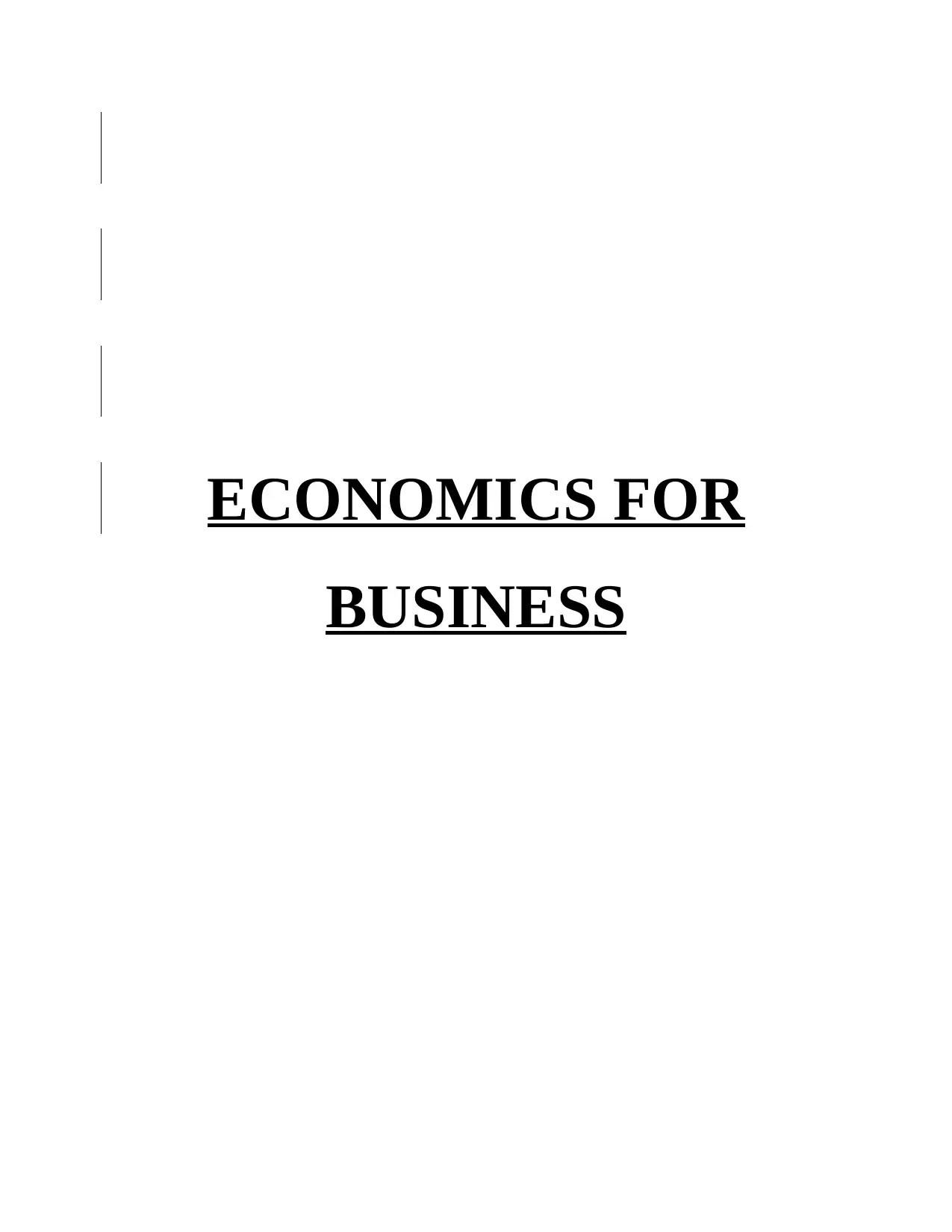
ECONOMICS FOR
BUSINESS
BUSINESS
Paraphrase This Document
Need a fresh take? Get an instant paraphrase of this document with our AI Paraphraser
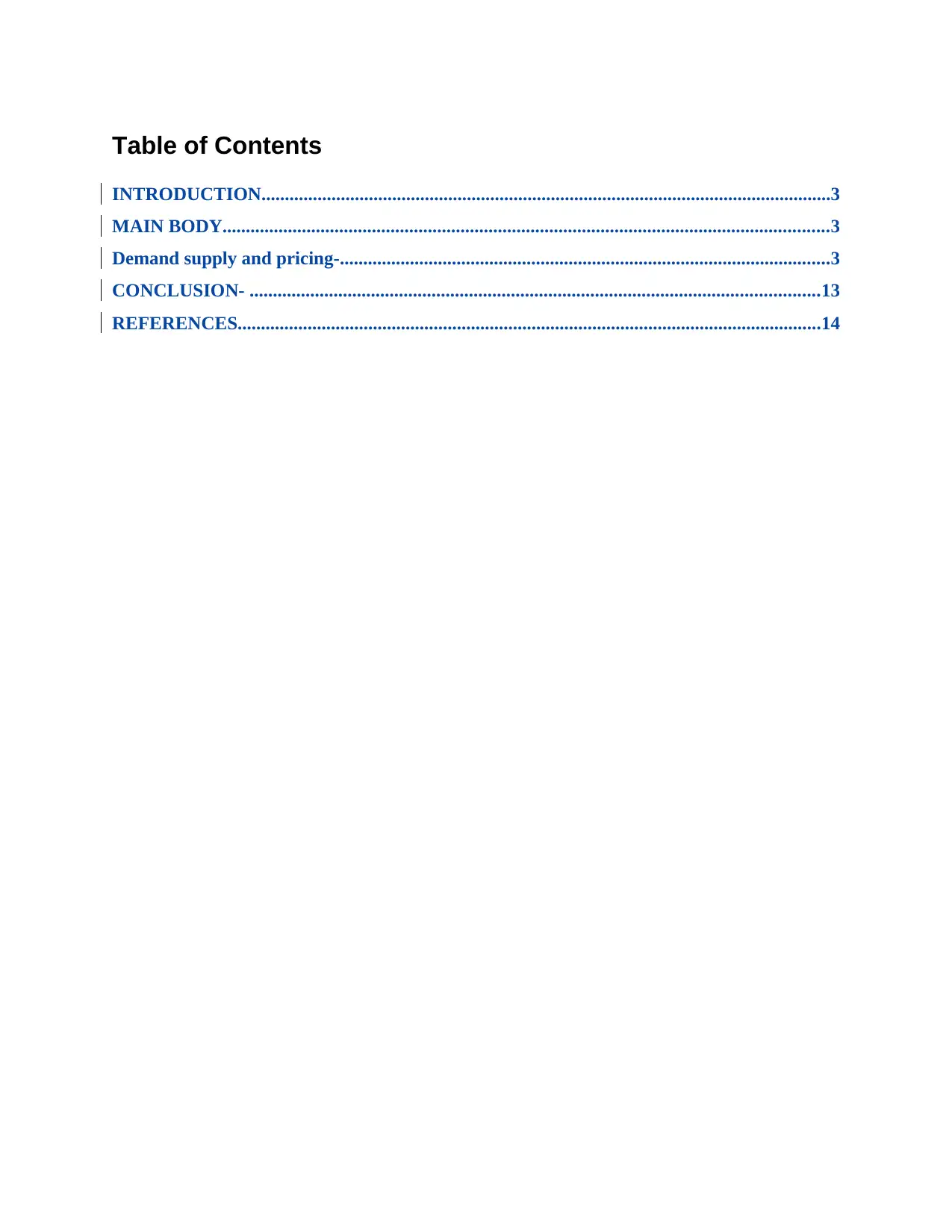
Table of Contents
INTRODUCTION..........................................................................................................................3
MAIN BODY..................................................................................................................................3
Demand supply and pricing-.........................................................................................................3
CONCLUSION- ..........................................................................................................................13
REFERENCES.............................................................................................................................14
INTRODUCTION..........................................................................................................................3
MAIN BODY..................................................................................................................................3
Demand supply and pricing-.........................................................................................................3
CONCLUSION- ..........................................................................................................................13
REFERENCES.............................................................................................................................14
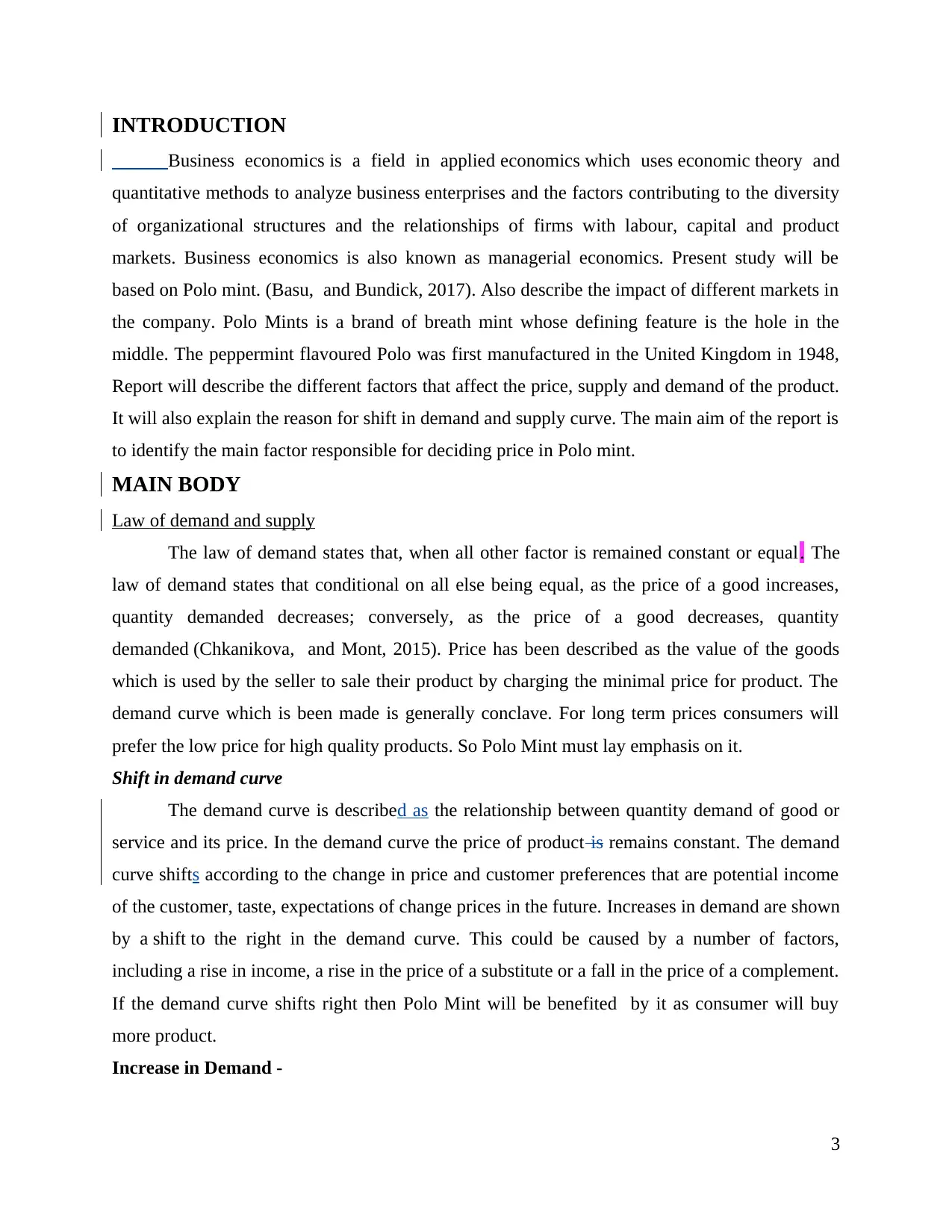
INTRODUCTION
Business economics is a field in applied economics which uses economic theory and
quantitative methods to analyze business enterprises and the factors contributing to the diversity
of organizational structures and the relationships of firms with labour, capital and product
markets. Business economics is also known as managerial economics. Present study will be
based on Polo mint. (Basu, and Bundick, 2017). Also describe the impact of different markets in
the company. Polo Mints is a brand of breath mint whose defining feature is the hole in the
middle. The peppermint flavoured Polo was first manufactured in the United Kingdom in 1948,
Report will describe the different factors that affect the price, supply and demand of the product.
It will also explain the reason for shift in demand and supply curve. The main aim of the report is
to identify the main factor responsible for deciding price in Polo mint.
MAIN BODY
Law of demand and supply
The law of demand states that, when all other factor is remained constant or equal. The
law of demand states that conditional on all else being equal, as the price of a good increases,
quantity demanded decreases; conversely, as the price of a good decreases, quantity
demanded (Chkanikova, and Mont, 2015). Price has been described as the value of the goods
which is used by the seller to sale their product by charging the minimal price for product. The
demand curve which is been made is generally conclave. For long term prices consumers will
prefer the low price for high quality products. So Polo Mint must lay emphasis on it.
Shift in demand curve
The demand curve is described as the relationship between quantity demand of good or
service and its price. In the demand curve the price of product is remains constant. The demand
curve shifts according to the change in price and customer preferences that are potential income
of the customer, taste, expectations of change prices in the future. Increases in demand are shown
by a shift to the right in the demand curve. This could be caused by a number of factors,
including a rise in income, a rise in the price of a substitute or a fall in the price of a complement.
If the demand curve shifts right then Polo Mint will be benefited by it as consumer will buy
more product.
Increase in Demand -
3
Business economics is a field in applied economics which uses economic theory and
quantitative methods to analyze business enterprises and the factors contributing to the diversity
of organizational structures and the relationships of firms with labour, capital and product
markets. Business economics is also known as managerial economics. Present study will be
based on Polo mint. (Basu, and Bundick, 2017). Also describe the impact of different markets in
the company. Polo Mints is a brand of breath mint whose defining feature is the hole in the
middle. The peppermint flavoured Polo was first manufactured in the United Kingdom in 1948,
Report will describe the different factors that affect the price, supply and demand of the product.
It will also explain the reason for shift in demand and supply curve. The main aim of the report is
to identify the main factor responsible for deciding price in Polo mint.
MAIN BODY
Law of demand and supply
The law of demand states that, when all other factor is remained constant or equal. The
law of demand states that conditional on all else being equal, as the price of a good increases,
quantity demanded decreases; conversely, as the price of a good decreases, quantity
demanded (Chkanikova, and Mont, 2015). Price has been described as the value of the goods
which is used by the seller to sale their product by charging the minimal price for product. The
demand curve which is been made is generally conclave. For long term prices consumers will
prefer the low price for high quality products. So Polo Mint must lay emphasis on it.
Shift in demand curve
The demand curve is described as the relationship between quantity demand of good or
service and its price. In the demand curve the price of product is remains constant. The demand
curve shifts according to the change in price and customer preferences that are potential income
of the customer, taste, expectations of change prices in the future. Increases in demand are shown
by a shift to the right in the demand curve. This could be caused by a number of factors,
including a rise in income, a rise in the price of a substitute or a fall in the price of a complement.
If the demand curve shifts right then Polo Mint will be benefited by it as consumer will buy
more product.
Increase in Demand -
3
⊘ This is a preview!⊘
Do you want full access?
Subscribe today to unlock all pages.

Trusted by 1+ million students worldwide
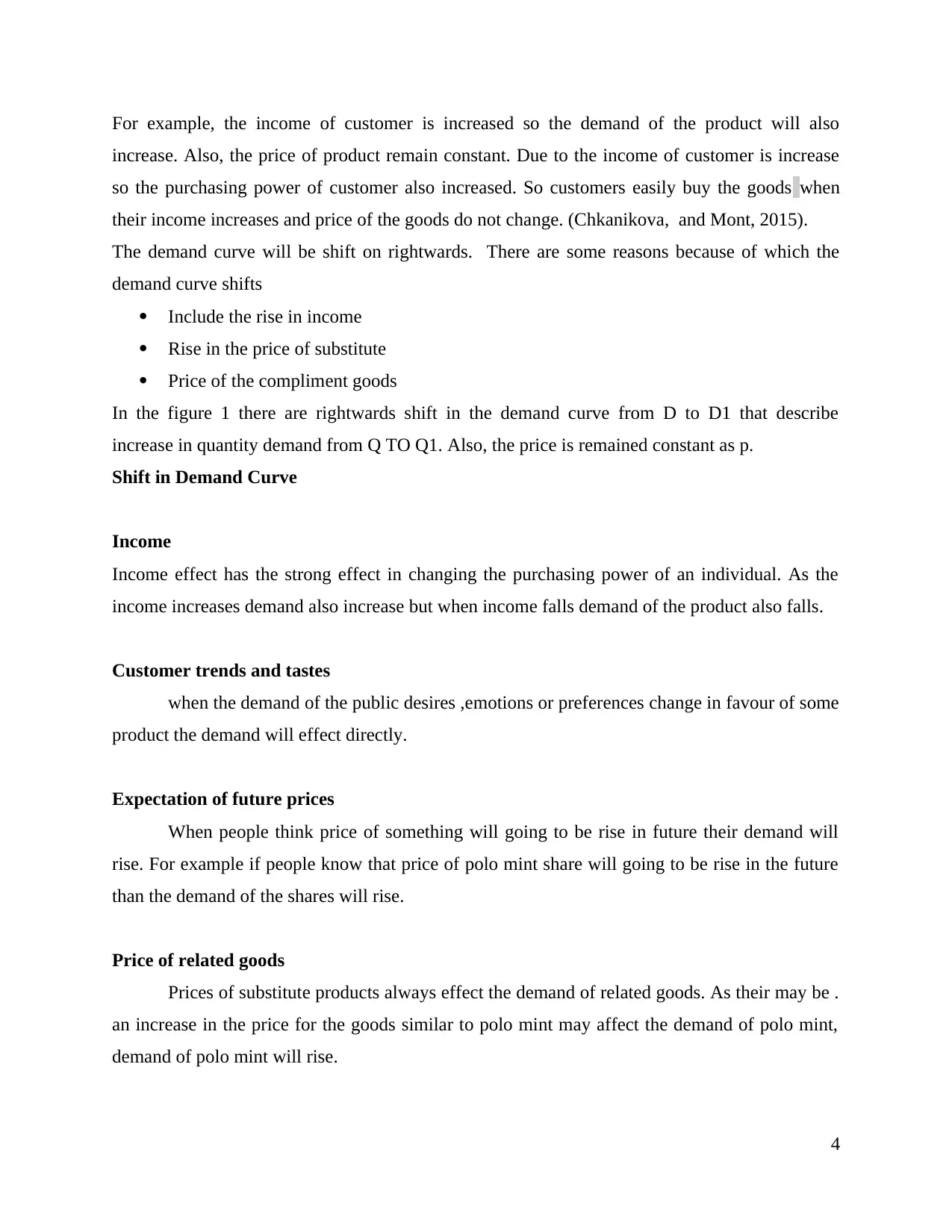
For example, the income of customer is increased so the demand of the product will also
increase. Also, the price of product remain constant. Due to the income of customer is increase
so the purchasing power of customer also increased. So customers easily buy the goods when
their income increases and price of the goods do not change. (Chkanikova, and Mont, 2015).
The demand curve will be shift on rightwards. There are some reasons because of which the
demand curve shifts
Include the rise in income
Rise in the price of substitute
Price of the compliment goods
In the figure 1 there are rightwards shift in the demand curve from D to D1 that describe
increase in quantity demand from Q TO Q1. Also, the price is remained constant as p.
Shift in Demand Curve
Income
Income effect has the strong effect in changing the purchasing power of an individual. As the
income increases demand also increase but when income falls demand of the product also falls.
Customer trends and tastes
when the demand of the public desires ,emotions or preferences change in favour of some
product the demand will effect directly.
Expectation of future prices
When people think price of something will going to be rise in future their demand will
rise. For example if people know that price of polo mint share will going to be rise in the future
than the demand of the shares will rise.
Price of related goods
Prices of substitute products always effect the demand of related goods. As their may be .
an increase in the price for the goods similar to polo mint may affect the demand of polo mint,
demand of polo mint will rise.
4
increase. Also, the price of product remain constant. Due to the income of customer is increase
so the purchasing power of customer also increased. So customers easily buy the goods when
their income increases and price of the goods do not change. (Chkanikova, and Mont, 2015).
The demand curve will be shift on rightwards. There are some reasons because of which the
demand curve shifts
Include the rise in income
Rise in the price of substitute
Price of the compliment goods
In the figure 1 there are rightwards shift in the demand curve from D to D1 that describe
increase in quantity demand from Q TO Q1. Also, the price is remained constant as p.
Shift in Demand Curve
Income
Income effect has the strong effect in changing the purchasing power of an individual. As the
income increases demand also increase but when income falls demand of the product also falls.
Customer trends and tastes
when the demand of the public desires ,emotions or preferences change in favour of some
product the demand will effect directly.
Expectation of future prices
When people think price of something will going to be rise in future their demand will
rise. For example if people know that price of polo mint share will going to be rise in the future
than the demand of the shares will rise.
Price of related goods
Prices of substitute products always effect the demand of related goods. As their may be .
an increase in the price for the goods similar to polo mint may affect the demand of polo mint,
demand of polo mint will rise.
4
Paraphrase This Document
Need a fresh take? Get an instant paraphrase of this document with our AI Paraphraser
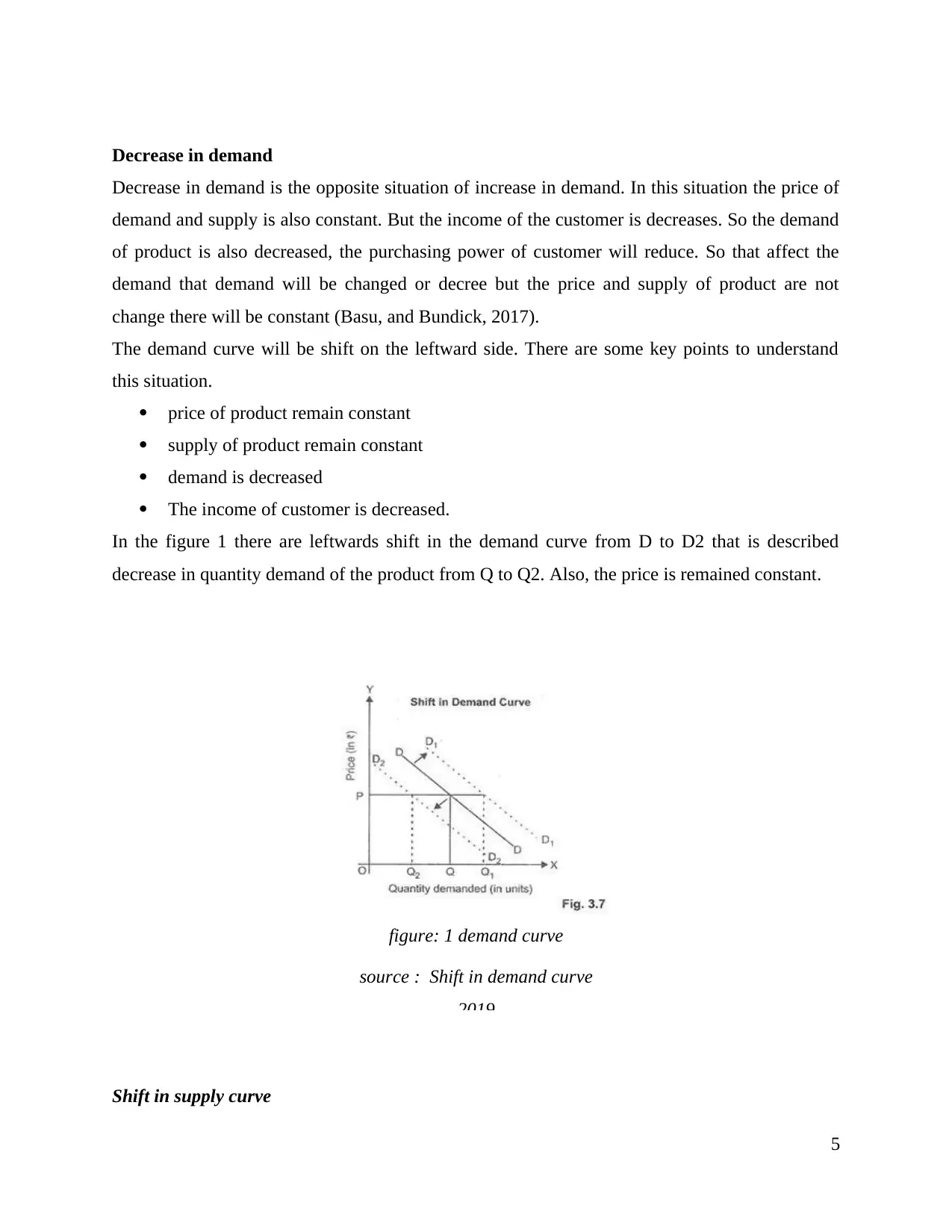
Decrease in demand
Decrease in demand is the opposite situation of increase in demand. In this situation the price of
demand and supply is also constant. But the income of the customer is decreases. So the demand
of product is also decreased, the purchasing power of customer will reduce. So that affect the
demand that demand will be changed or decree but the price and supply of product are not
change there will be constant (Basu, and Bundick, 2017).
The demand curve will be shift on the leftward side. There are some key points to understand
this situation.
price of product remain constant
supply of product remain constant
demand is decreased
The income of customer is decreased.
In the figure 1 there are leftwards shift in the demand curve from D to D2 that is described
decrease in quantity demand of the product from Q to Q2. Also, the price is remained constant.
Shift in supply curve
5
figure: 1 demand curve
source : Shift in demand curve
2019
Decrease in demand is the opposite situation of increase in demand. In this situation the price of
demand and supply is also constant. But the income of the customer is decreases. So the demand
of product is also decreased, the purchasing power of customer will reduce. So that affect the
demand that demand will be changed or decree but the price and supply of product are not
change there will be constant (Basu, and Bundick, 2017).
The demand curve will be shift on the leftward side. There are some key points to understand
this situation.
price of product remain constant
supply of product remain constant
demand is decreased
The income of customer is decreased.
In the figure 1 there are leftwards shift in the demand curve from D to D2 that is described
decrease in quantity demand of the product from Q to Q2. Also, the price is remained constant.
Shift in supply curve
5
figure: 1 demand curve
source : Shift in demand curve
2019
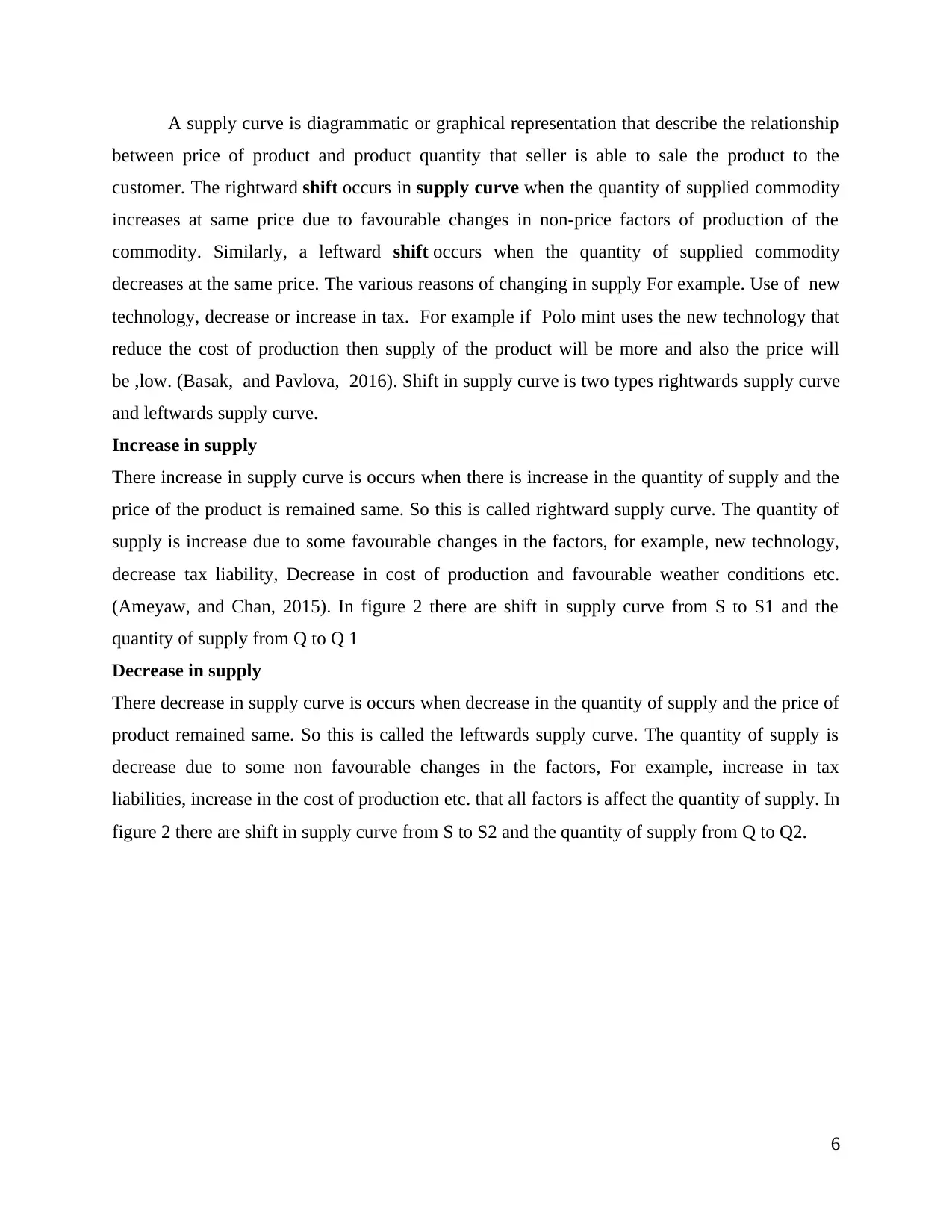
A supply curve is diagrammatic or graphical representation that describe the relationship
between price of product and product quantity that seller is able to sale the product to the
customer. The rightward shift occurs in supply curve when the quantity of supplied commodity
increases at same price due to favourable changes in non-price factors of production of the
commodity. Similarly, a leftward shift occurs when the quantity of supplied commodity
decreases at the same price. The various reasons of changing in supply For example. Use of new
technology, decrease or increase in tax. For example if Polo mint uses the new technology that
reduce the cost of production then supply of the product will be more and also the price will
be ,low. (Basak, and Pavlova, 2016). Shift in supply curve is two types rightwards supply curve
and leftwards supply curve.
Increase in supply
There increase in supply curve is occurs when there is increase in the quantity of supply and the
price of the product is remained same. So this is called rightward supply curve. The quantity of
supply is increase due to some favourable changes in the factors, for example, new technology,
decrease tax liability, Decrease in cost of production and favourable weather conditions etc.
(Ameyaw, and Chan, 2015). In figure 2 there are shift in supply curve from S to S1 and the
quantity of supply from Q to Q 1
Decrease in supply
There decrease in supply curve is occurs when decrease in the quantity of supply and the price of
product remained same. So this is called the leftwards supply curve. The quantity of supply is
decrease due to some non favourable changes in the factors, For example, increase in tax
liabilities, increase in the cost of production etc. that all factors is affect the quantity of supply. In
figure 2 there are shift in supply curve from S to S2 and the quantity of supply from Q to Q2.
6
between price of product and product quantity that seller is able to sale the product to the
customer. The rightward shift occurs in supply curve when the quantity of supplied commodity
increases at same price due to favourable changes in non-price factors of production of the
commodity. Similarly, a leftward shift occurs when the quantity of supplied commodity
decreases at the same price. The various reasons of changing in supply For example. Use of new
technology, decrease or increase in tax. For example if Polo mint uses the new technology that
reduce the cost of production then supply of the product will be more and also the price will
be ,low. (Basak, and Pavlova, 2016). Shift in supply curve is two types rightwards supply curve
and leftwards supply curve.
Increase in supply
There increase in supply curve is occurs when there is increase in the quantity of supply and the
price of the product is remained same. So this is called rightward supply curve. The quantity of
supply is increase due to some favourable changes in the factors, for example, new technology,
decrease tax liability, Decrease in cost of production and favourable weather conditions etc.
(Ameyaw, and Chan, 2015). In figure 2 there are shift in supply curve from S to S1 and the
quantity of supply from Q to Q 1
Decrease in supply
There decrease in supply curve is occurs when decrease in the quantity of supply and the price of
product remained same. So this is called the leftwards supply curve. The quantity of supply is
decrease due to some non favourable changes in the factors, For example, increase in tax
liabilities, increase in the cost of production etc. that all factors is affect the quantity of supply. In
figure 2 there are shift in supply curve from S to S2 and the quantity of supply from Q to Q2.
6
⊘ This is a preview!⊘
Do you want full access?
Subscribe today to unlock all pages.

Trusted by 1+ million students worldwide
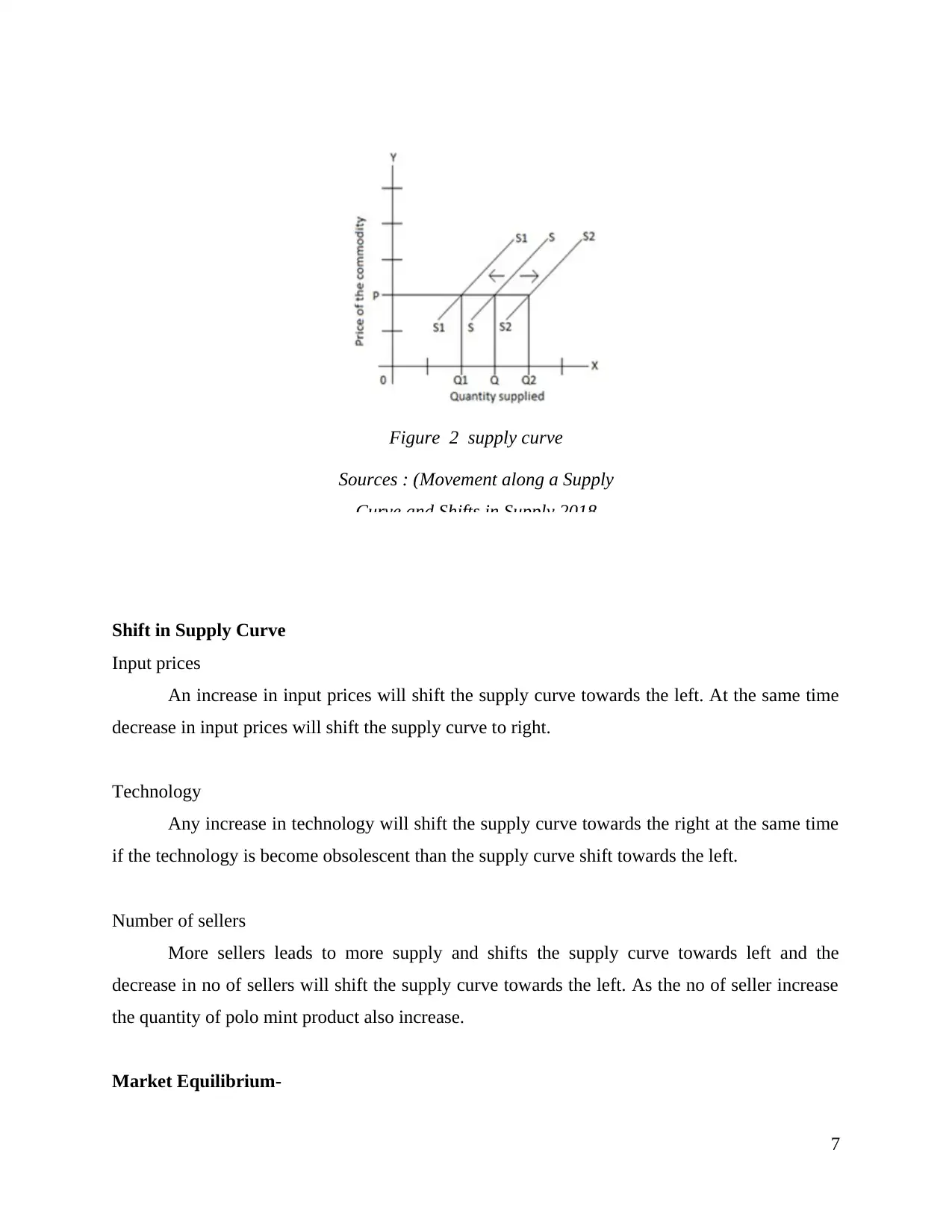
Shift in Supply Curve
Input prices
An increase in input prices will shift the supply curve towards the left. At the same time
decrease in input prices will shift the supply curve to right.
Technology
Any increase in technology will shift the supply curve towards the right at the same time
if the technology is become obsolescent than the supply curve shift towards the left.
Number of sellers
More sellers leads to more supply and shifts the supply curve towards left and the
decrease in no of sellers will shift the supply curve towards the left. As the no of seller increase
the quantity of polo mint product also increase.
Market Equilibrium-
7
Figure 2 supply curve
Sources : (Movement along a Supply
Curve and Shifts in Supply 2018
Input prices
An increase in input prices will shift the supply curve towards the left. At the same time
decrease in input prices will shift the supply curve to right.
Technology
Any increase in technology will shift the supply curve towards the right at the same time
if the technology is become obsolescent than the supply curve shift towards the left.
Number of sellers
More sellers leads to more supply and shifts the supply curve towards left and the
decrease in no of sellers will shift the supply curve towards the left. As the no of seller increase
the quantity of polo mint product also increase.
Market Equilibrium-
7
Figure 2 supply curve
Sources : (Movement along a Supply
Curve and Shifts in Supply 2018
Paraphrase This Document
Need a fresh take? Get an instant paraphrase of this document with our AI Paraphraser
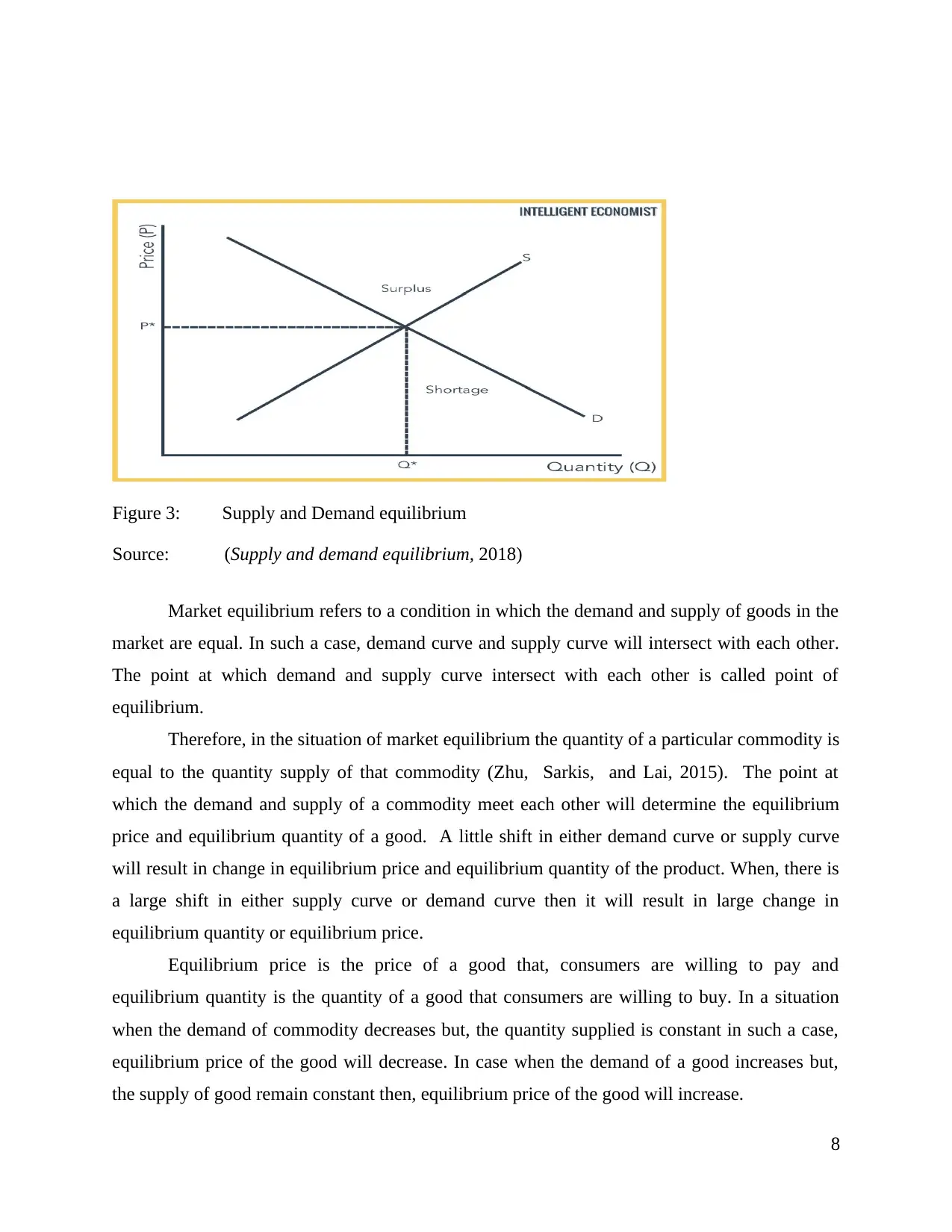
Market equilibrium refers to a condition in which the demand and supply of goods in the
market are equal. In such a case, demand curve and supply curve will intersect with each other.
The point at which demand and supply curve intersect with each other is called point of
equilibrium.
Therefore, in the situation of market equilibrium the quantity of a particular commodity is
equal to the quantity supply of that commodity (Zhu, Sarkis, and Lai, 2015). The point at
which the demand and supply of a commodity meet each other will determine the equilibrium
price and equilibrium quantity of a good. A little shift in either demand curve or supply curve
will result in change in equilibrium price and equilibrium quantity of the product. When, there is
a large shift in either supply curve or demand curve then it will result in large change in
equilibrium quantity or equilibrium price.
Equilibrium price is the price of a good that, consumers are willing to pay and
equilibrium quantity is the quantity of a good that consumers are willing to buy. In a situation
when the demand of commodity decreases but, the quantity supplied is constant in such a case,
equilibrium price of the good will decrease. In case when the demand of a good increases but,
the supply of good remain constant then, equilibrium price of the good will increase.
8
Figure 3: Supply and Demand equilibrium
Source: (Supply and demand equilibrium, 2018)
market are equal. In such a case, demand curve and supply curve will intersect with each other.
The point at which demand and supply curve intersect with each other is called point of
equilibrium.
Therefore, in the situation of market equilibrium the quantity of a particular commodity is
equal to the quantity supply of that commodity (Zhu, Sarkis, and Lai, 2015). The point at
which the demand and supply of a commodity meet each other will determine the equilibrium
price and equilibrium quantity of a good. A little shift in either demand curve or supply curve
will result in change in equilibrium price and equilibrium quantity of the product. When, there is
a large shift in either supply curve or demand curve then it will result in large change in
equilibrium quantity or equilibrium price.
Equilibrium price is the price of a good that, consumers are willing to pay and
equilibrium quantity is the quantity of a good that consumers are willing to buy. In a situation
when the demand of commodity decreases but, the quantity supplied is constant in such a case,
equilibrium price of the good will decrease. In case when the demand of a good increases but,
the supply of good remain constant then, equilibrium price of the good will increase.
8
Figure 3: Supply and Demand equilibrium
Source: (Supply and demand equilibrium, 2018)
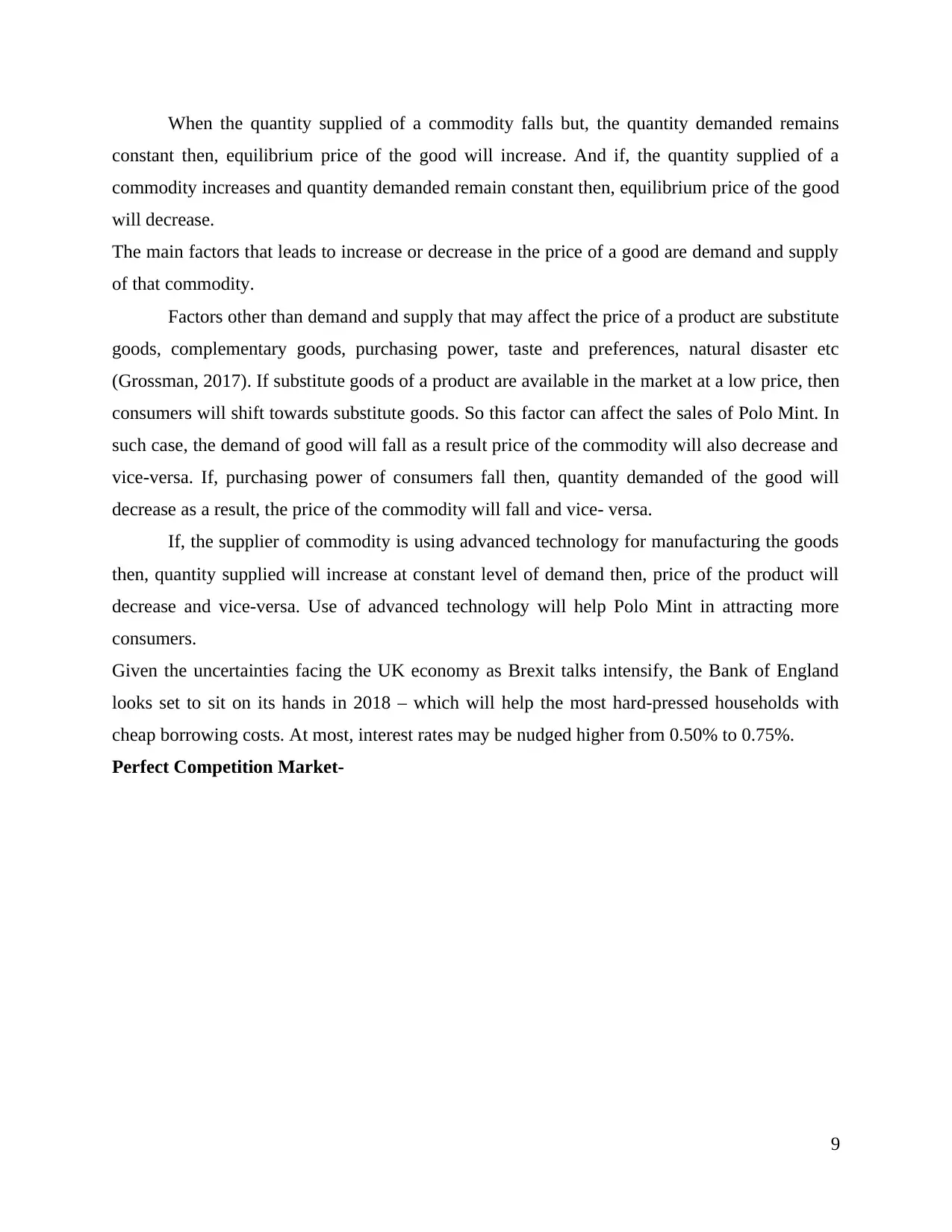
When the quantity supplied of a commodity falls but, the quantity demanded remains
constant then, equilibrium price of the good will increase. And if, the quantity supplied of a
commodity increases and quantity demanded remain constant then, equilibrium price of the good
will decrease.
The main factors that leads to increase or decrease in the price of a good are demand and supply
of that commodity.
Factors other than demand and supply that may affect the price of a product are substitute
goods, complementary goods, purchasing power, taste and preferences, natural disaster etc
(Grossman, 2017). If substitute goods of a product are available in the market at a low price, then
consumers will shift towards substitute goods. So this factor can affect the sales of Polo Mint. In
such case, the demand of good will fall as a result price of the commodity will also decrease and
vice-versa. If, purchasing power of consumers fall then, quantity demanded of the good will
decrease as a result, the price of the commodity will fall and vice- versa.
If, the supplier of commodity is using advanced technology for manufacturing the goods
then, quantity supplied will increase at constant level of demand then, price of the product will
decrease and vice-versa. Use of advanced technology will help Polo Mint in attracting more
consumers.
Given the uncertainties facing the UK economy as Brexit talks intensify, the Bank of England
looks set to sit on its hands in 2018 – which will help the most hard-pressed households with
cheap borrowing costs. At most, interest rates may be nudged higher from 0.50% to 0.75%.
Perfect Competition Market-
9
constant then, equilibrium price of the good will increase. And if, the quantity supplied of a
commodity increases and quantity demanded remain constant then, equilibrium price of the good
will decrease.
The main factors that leads to increase or decrease in the price of a good are demand and supply
of that commodity.
Factors other than demand and supply that may affect the price of a product are substitute
goods, complementary goods, purchasing power, taste and preferences, natural disaster etc
(Grossman, 2017). If substitute goods of a product are available in the market at a low price, then
consumers will shift towards substitute goods. So this factor can affect the sales of Polo Mint. In
such case, the demand of good will fall as a result price of the commodity will also decrease and
vice-versa. If, purchasing power of consumers fall then, quantity demanded of the good will
decrease as a result, the price of the commodity will fall and vice- versa.
If, the supplier of commodity is using advanced technology for manufacturing the goods
then, quantity supplied will increase at constant level of demand then, price of the product will
decrease and vice-versa. Use of advanced technology will help Polo Mint in attracting more
consumers.
Given the uncertainties facing the UK economy as Brexit talks intensify, the Bank of England
looks set to sit on its hands in 2018 – which will help the most hard-pressed households with
cheap borrowing costs. At most, interest rates may be nudged higher from 0.50% to 0.75%.
Perfect Competition Market-
9
⊘ This is a preview!⊘
Do you want full access?
Subscribe today to unlock all pages.

Trusted by 1+ million students worldwide
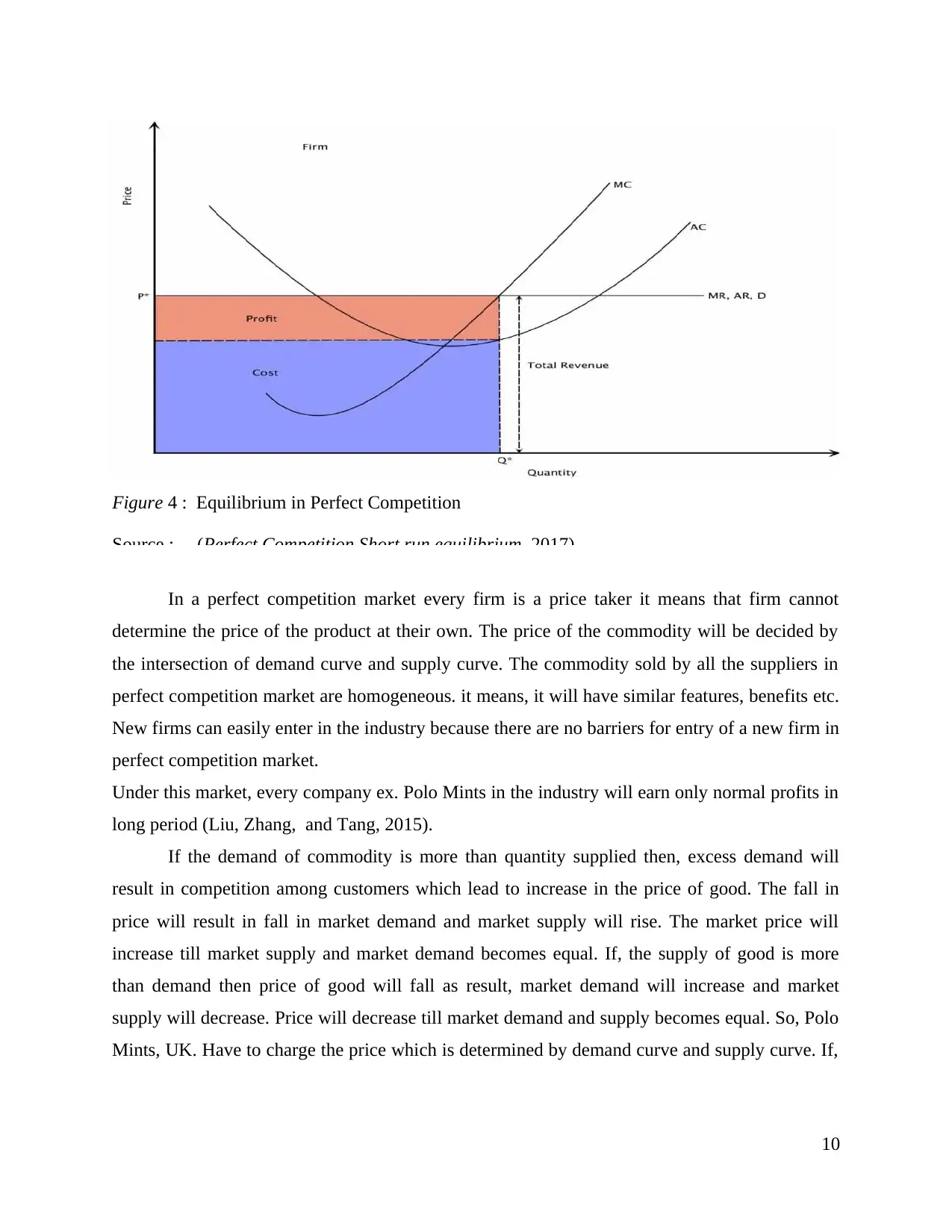
In a perfect competition market every firm is a price taker it means that firm cannot
determine the price of the product at their own. The price of the commodity will be decided by
the intersection of demand curve and supply curve. The commodity sold by all the suppliers in
perfect competition market are homogeneous. it means, it will have similar features, benefits etc.
New firms can easily enter in the industry because there are no barriers for entry of a new firm in
perfect competition market.
Under this market, every company ex. Polo Mints in the industry will earn only normal profits in
long period (Liu, Zhang, and Tang, 2015).
If the demand of commodity is more than quantity supplied then, excess demand will
result in competition among customers which lead to increase in the price of good. The fall in
price will result in fall in market demand and market supply will rise. The market price will
increase till market supply and market demand becomes equal. If, the supply of good is more
than demand then price of good will fall as result, market demand will increase and market
supply will decrease. Price will decrease till market demand and supply becomes equal. So, Polo
Mints, UK. Have to charge the price which is determined by demand curve and supply curve. If,
10
Figure 4 : Equilibrium in Perfect Competition
Source : (Perfect Competition Short run equilibrium, 2017)
determine the price of the product at their own. The price of the commodity will be decided by
the intersection of demand curve and supply curve. The commodity sold by all the suppliers in
perfect competition market are homogeneous. it means, it will have similar features, benefits etc.
New firms can easily enter in the industry because there are no barriers for entry of a new firm in
perfect competition market.
Under this market, every company ex. Polo Mints in the industry will earn only normal profits in
long period (Liu, Zhang, and Tang, 2015).
If the demand of commodity is more than quantity supplied then, excess demand will
result in competition among customers which lead to increase in the price of good. The fall in
price will result in fall in market demand and market supply will rise. The market price will
increase till market supply and market demand becomes equal. If, the supply of good is more
than demand then price of good will fall as result, market demand will increase and market
supply will decrease. Price will decrease till market demand and supply becomes equal. So, Polo
Mints, UK. Have to charge the price which is determined by demand curve and supply curve. If,
10
Figure 4 : Equilibrium in Perfect Competition
Source : (Perfect Competition Short run equilibrium, 2017)
Paraphrase This Document
Need a fresh take? Get an instant paraphrase of this document with our AI Paraphraser
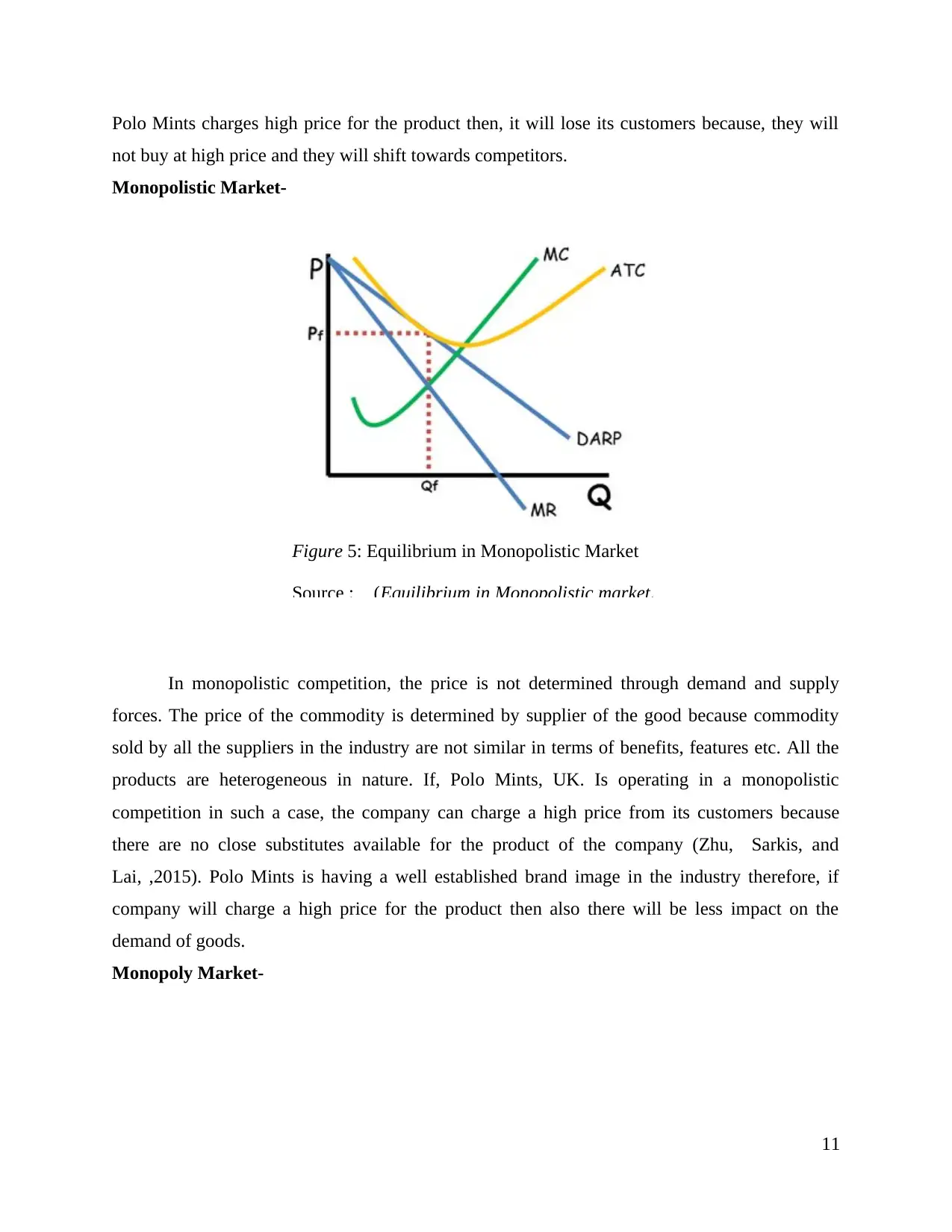
Polo Mints charges high price for the product then, it will lose its customers because, they will
not buy at high price and they will shift towards competitors.
Monopolistic Market-
In monopolistic competition, the price is not determined through demand and supply
forces. The price of the commodity is determined by supplier of the good because commodity
sold by all the suppliers in the industry are not similar in terms of benefits, features etc. All the
products are heterogeneous in nature. If, Polo Mints, UK. Is operating in a monopolistic
competition in such a case, the company can charge a high price from its customers because
there are no close substitutes available for the product of the company (Zhu, Sarkis, and
Lai, ,2015). Polo Mints is having a well established brand image in the industry therefore, if
company will charge a high price for the product then also there will be less impact on the
demand of goods.
Monopoly Market-
11
Figure 5: Equilibrium in Monopolistic Market
Source : (Equilibrium in Monopolistic market,
not buy at high price and they will shift towards competitors.
Monopolistic Market-
In monopolistic competition, the price is not determined through demand and supply
forces. The price of the commodity is determined by supplier of the good because commodity
sold by all the suppliers in the industry are not similar in terms of benefits, features etc. All the
products are heterogeneous in nature. If, Polo Mints, UK. Is operating in a monopolistic
competition in such a case, the company can charge a high price from its customers because
there are no close substitutes available for the product of the company (Zhu, Sarkis, and
Lai, ,2015). Polo Mints is having a well established brand image in the industry therefore, if
company will charge a high price for the product then also there will be less impact on the
demand of goods.
Monopoly Market-
11
Figure 5: Equilibrium in Monopolistic Market
Source : (Equilibrium in Monopolistic market,
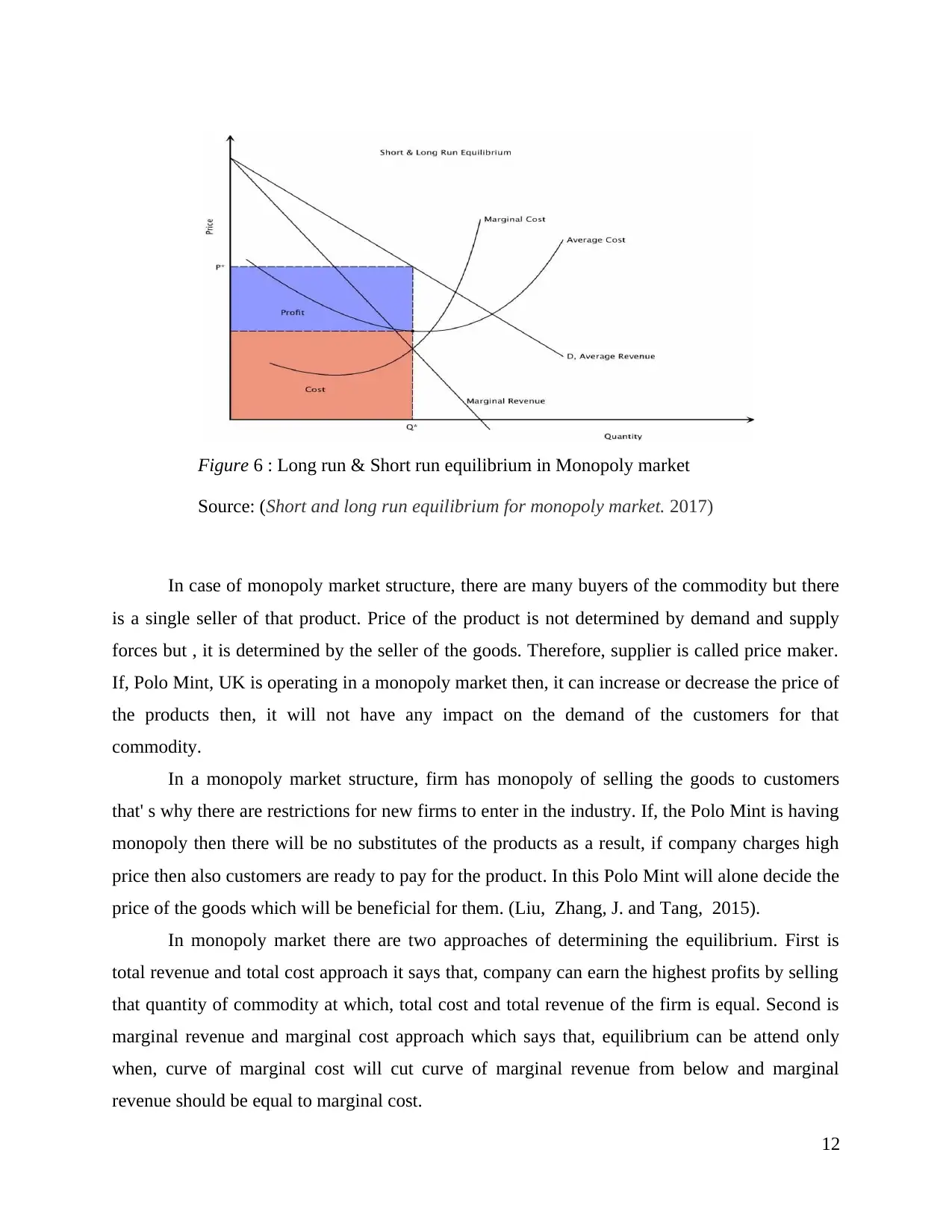
In case of monopoly market structure, there are many buyers of the commodity but there
is a single seller of that product. Price of the product is not determined by demand and supply
forces but , it is determined by the seller of the goods. Therefore, supplier is called price maker.
If, Polo Mint, UK is operating in a monopoly market then, it can increase or decrease the price of
the products then, it will not have any impact on the demand of the customers for that
commodity.
In a monopoly market structure, firm has monopoly of selling the goods to customers
that' s why there are restrictions for new firms to enter in the industry. If, the Polo Mint is having
monopoly then there will be no substitutes of the products as a result, if company charges high
price then also customers are ready to pay for the product. In this Polo Mint will alone decide the
price of the goods which will be beneficial for them. (Liu, Zhang, J. and Tang, 2015).
In monopoly market there are two approaches of determining the equilibrium. First is
total revenue and total cost approach it says that, company can earn the highest profits by selling
that quantity of commodity at which, total cost and total revenue of the firm is equal. Second is
marginal revenue and marginal cost approach which says that, equilibrium can be attend only
when, curve of marginal cost will cut curve of marginal revenue from below and marginal
revenue should be equal to marginal cost.
12
Figure 6 : Long run & Short run equilibrium in Monopoly market
Source: (Short and long run equilibrium for monopoly market. 2017)
is a single seller of that product. Price of the product is not determined by demand and supply
forces but , it is determined by the seller of the goods. Therefore, supplier is called price maker.
If, Polo Mint, UK is operating in a monopoly market then, it can increase or decrease the price of
the products then, it will not have any impact on the demand of the customers for that
commodity.
In a monopoly market structure, firm has monopoly of selling the goods to customers
that' s why there are restrictions for new firms to enter in the industry. If, the Polo Mint is having
monopoly then there will be no substitutes of the products as a result, if company charges high
price then also customers are ready to pay for the product. In this Polo Mint will alone decide the
price of the goods which will be beneficial for them. (Liu, Zhang, J. and Tang, 2015).
In monopoly market there are two approaches of determining the equilibrium. First is
total revenue and total cost approach it says that, company can earn the highest profits by selling
that quantity of commodity at which, total cost and total revenue of the firm is equal. Second is
marginal revenue and marginal cost approach which says that, equilibrium can be attend only
when, curve of marginal cost will cut curve of marginal revenue from below and marginal
revenue should be equal to marginal cost.
12
Figure 6 : Long run & Short run equilibrium in Monopoly market
Source: (Short and long run equilibrium for monopoly market. 2017)
⊘ This is a preview!⊘
Do you want full access?
Subscribe today to unlock all pages.

Trusted by 1+ million students worldwide
1 out of 16
Related Documents
Your All-in-One AI-Powered Toolkit for Academic Success.
+13062052269
info@desklib.com
Available 24*7 on WhatsApp / Email
![[object Object]](/_next/static/media/star-bottom.7253800d.svg)
Unlock your academic potential
Copyright © 2020–2025 A2Z Services. All Rights Reserved. Developed and managed by ZUCOL.




